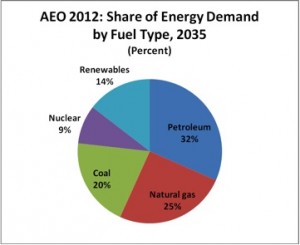The IEA, the International Energy Agency, on November 12, 2012, released its forecast on the state of the world energy mix by 2035. For environmentalists seeking an energy world vastly different from the one today, there will be disappointment. Fossil fuels in the form of oil, coal and gas will remain the predominant energy sources. Renewable energy will, however, continue to increase as a percentage of the total amount of energy produced.
As for the current state of energy on the planet, the IEA report notes:
- A North American resurgence in oil production coming from the United States and Canada with the bulk of new energy in coming from unconventional sources including oil sands, and oil and gas shale.
- A resurgence in conventional oil production in Iraq as the infrastructure rebuild leads to new capacity following the Iraqi war.
- A retreat from nuclear following the disaster in Fukushima.
- More countries legislating energy efficiency.
- High oil and gas prices contributing to slowing the growth of the world economy.
- Record high CO2 emissions at 1.5 gigatons in 2011
- Renewable energy sources constrained by a lack of sustained government support.
- 1.3 billion still with no access to electricity today and 2.6 billion lack clean cooking facilities, more than half living in India, China and Bangladesh.
- Global energy demand growing faster in the Developing rather than the Developed World where demand is static.
The IEA crystal ball predicts by 2035 the following;
- Iraq will account for 45% of the growth in global oil production and the country will become the second largest exporter by the 2030s, overtaking Russia.
- Middle East oil’s destination will largely be Asia with North America becoming a net exporter of oil and liquid natural gas.
- Unconventional sources will be disruptive to traditional oil and gas suppliers changing trade patterns.
- Nuclear will increase as new fission and dual fission-fusion reactor technologies are perfected.
- While China, India, the European Union and Japan will see increases in oil imports, the United States will see a decline becoming a net exporter.
- Worldwide energy demand will increase by 70%.
- Half of the new global capacity will be filled by renewable energy sources with China the predominant market.
- Energy subsidies for renewables will continue to build capacity to meet long-term demand forecasts.
- The cost of electricity for domestic use will continue to climb globally.
- Access to water will be critical to assessing new energy projects.
- In the Developed World unrealized energy efficiency will be the single biggest factor in driving up any future demand unless governments implement measures to encourage and enforce conservation.
- Improved energy efficiency will contribute to stabilizing CO2 emissions but the world will see better than a 2 degree Celsius rise in average global temperatures well before 2035 based on current emission trends.
- Carbon capture and sequestration will contribute to 20% of required emission reductions but those results will happen not by 2035 but by 2050.
- 1 billion will continue to have no access to electricity with estimates of $1 trillion needed to eliminate this deficiency.
In conclusion the IEA predicts the need for energy producers to increase capacity by 5,890 GigaWatts, more than the total installed capacity currently in the World. One-third of the new capacity will replace existing power plants that will go out of service. Renewables will contribute 3,000 GigaWatts. Total investment will exceed $16.9 trillion. Of the investment in renewables, 22% will go to wind energy projects, 16% to hydro, and 13% to solar. By 2035 global demand for electricity will reach 32,000 TeraWatt Hours.











